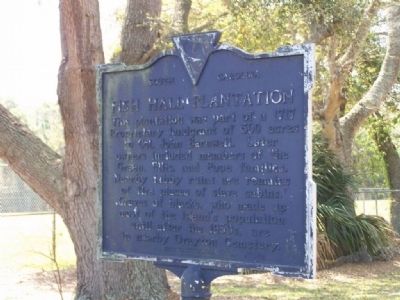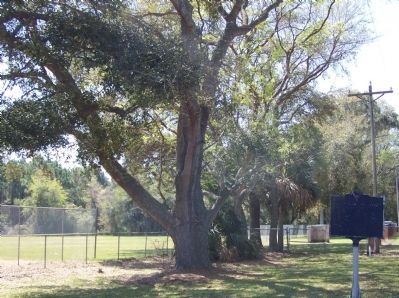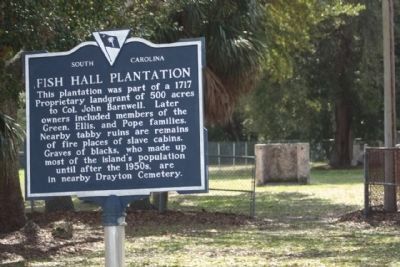Hilton Head Island in Beaufort County, South Carolina — The American South (South Atlantic)
Fish Hall Plantation
Erected 1985 by Beaufort County Council. (Marker Number 7-18.)
Topics. This historical marker is listed in these topic lists: African Americans • Colonial Era • Notable Places. A significant historical year for this entry is 1717.
Location. 32° 14.732′ N, 80° 41.793′ W. Marker is on Hilton Head Island, South Carolina, in Beaufort County. Marker is on Fish Haul Road near Mitchelville Road, on the right when traveling east. Marker is at Barker (baseball) Field. Touch for map. Marker is at or near this postal address: 12 Adell Ln, Hilton Head Island SC 29926, United States of America. Touch for directions.
Other nearby markers. At least 8 other markers are within walking distance of this marker. Thomas Fenwick Drayton (here, next to this marker); Mitchelville Site (approx. 0.8 miles away); Reconnecting with Family (approx. 0.8 miles away); Religion in Mitchelville/School in Mitchelville (approx. 0.8 miles away); Working for Wages/Freedmen’s Bureau (approx. 0.8 miles away); Mitchelville and Abolitionists (approx. 0.8 miles away); Cherry Hill School (approx. 0.8 miles away); Mitchelville Building Sites (approx. 0.8 miles away). Touch for a list and map of all markers in Hilton Head Island.
Regarding Fish Hall Plantation. Tabby is a building material, made from shells, lime, and water, which forms a sort of concrete. It was used for all sorts of structures, due to a shortage of brick.
Also see . . . National Register Properties in South Carolina. The Fish Haul site represents the only known freedmen village established by occupying Union troops. Listed in the National Register June 30, 1988. ****note**** Limited access, not for general public (Submitted on March 26, 2008, by Mike Stroud of Bluffton, South Carolina.)
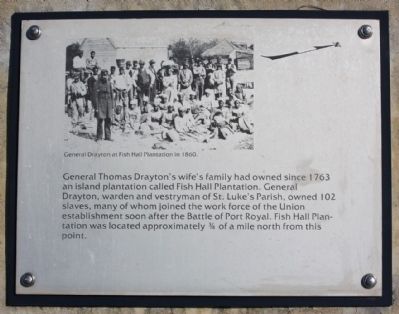
Photographed By Mike Stroud, 2009
4. Fish Hall Plantation , From Interpretive sign, Port Royal Plantation, Hilton Head Island
General Drayton at Fish Hall Plantation in 1860.
General Thomas Drayton's wife's family had
owned since 1763 an island plantation called
Fish Hall Plantation. General Drayton, warden
and Vestryman of St. Luke's Parish, owned
102 slaves, many of whom joined the work
force of the Union establishment soon after
the Battle of Port Royal. Fish Hall Plantation
was located approximately ¾ of a mile north
from this point. [ site of Fort Walker; coordinates
32.232742 -80.677156 ]
Editor's Note: The photo pictured here was taken in May 1862 by photographer Henry P. Moore (1833-1911) and is available through the Gladstone Collection in the Library of Congress.
Editor's Note: The photo pictured here was taken in May 1862 by photographer Henry P. Moore (1833-1911) and is available through the Gladstone Collection in the Library of Congress.
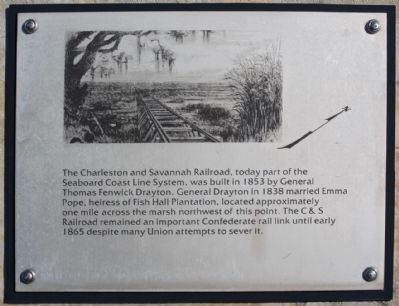
Photographed By Mike Stroud, 2009
5. Fish Hall Plantation, part of Interpretive Marker at Fort Walker site, Port Royal Plantation
The Charleston and Savannah Railroad, today
part of the Seaboard Coast Line System, [ CSX]
was built in 1853 by General Thomas Fenwick
Drayton. General Drayton in 1838 married Emma
Pope, heiress of Fish Hall Plantation, located
approximately one mile across the marsh
northwest of this point. The C&S Railroad
remained an important Confederate rail link
until early 1865 despite many Union attempts
to sever it.
Credits. This page was last revised on December 5, 2020. It was originally submitted on March 26, 2008, by Mike Stroud of Bluffton, South Carolina. This page has been viewed 4,880 times since then and 92 times this year. Photos: 1, 2. submitted on March 26, 2008, by Mike Stroud of Bluffton, South Carolina. 3. submitted on March 6, 2011, by Mike Stroud of Bluffton, South Carolina. 4, 5. submitted on February 10, 2009, by Mike Stroud of Bluffton, South Carolina. • Christopher Busta-Peck was the editor who published this page.
